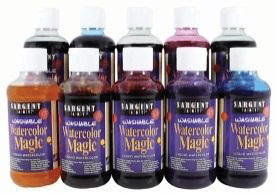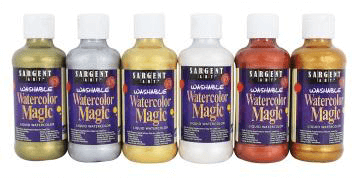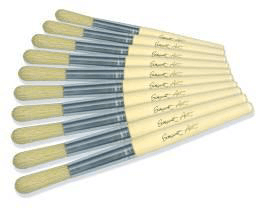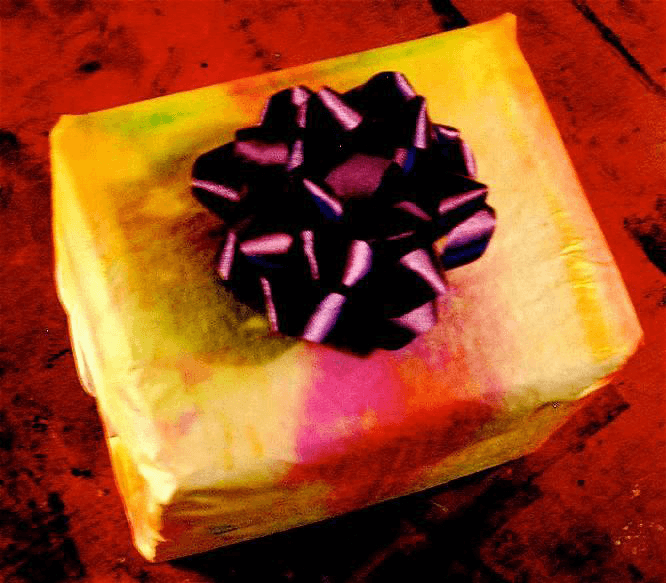Goal (Terminal Objective): Students will create gift wrapping paper in simulated tie- dye designs.
Objective: Each student will create a series of quick sculptural studies of classmates posing to display a variety of active movements.
National Standards:
Visual Arts Grades 5-8 Content Standard 1: Understanding and applying media, techniques, and processes
Visual Arts Grades 5-8 Content Standard 4: Understanding the visual arts in relation to history and cultures
Visual Arts Grades 5-8 Content Standard 5: Reflecting upon and assessing the characteristics and merits of their work and the work of others
Purpose: Students will use wet-on-wet watercolor technique and repetitive pattern design. Students will view and examine important works from the history of art.
Students will create a functional gift wrap design and product.
New Vocabulary: Tie-dye, pattern
Materials:
Sargent Watercolor Magic (Item #22-6010), Sargent Watercolor Magic Metallic Assortment (Item #22-6097), Sargent Chubby Brush Set (Item #56-1100), large sheets of white tissue paper
 #22-6010 10 pcs. 8oz ea. Washable Watercolor Magic
#22-6010 10 pcs. 8oz ea. Washable Watercolor Magic
 #22-6097 8oz. Washable Metallic Watercolor Magic 6 pcs.
#22-6097 8oz. Washable Metallic Watercolor Magic 6 pcs.
 #56-1100 Jumbo Brushes
#56-1100 Jumbo Brushes
Time: This lesson may be modified to last from two to four hours, depending upon size and complexity expectations.
Introduction and Motivation (Set):
Teacher presents and discusses tie-dye exemplars.
Instruction:
Teacher introduces the concepts of tie-dye and pattern design. Teacher organizes the classroom to facilitate students’ easy, orderly access to materials.
Activities:
(1) Guided Practice:
- Students reflect upon images provided by teacher.
- Students fold tissue paper into long pleats, 1 ½ inches wide.
- Students fold pleated tissue paper in half and, if desired, in half again. Sharpen creased edges.

- Students saturate the folded tissue with water. Squeegee out excess water with fingers.
- Students paint the edges with intense concentrations of Sargent Watercolor Magic, using a different color on each crease.

- Students CAREFULLY unfold the painted paper and allow it to dry in a protected area.

- If desired, students may refold and paint additional colors on the creases without saturating the paper.
- Allow to dry again.
(2) Independent Practice and Check for Understanding: Teacher circulates among the working students visually recording (checklist) students demonstrating understanding of objectives, asking direct questions when understanding isn’t observable, and asking peers to critique each other. Teacher helps and reinforces students as they work.
(3) Closure: Students display their work or use the paper to wrap gifts.
Evaluation:
Use teacher or class critiques to evaluate particularly strong works and strong qualities within works
Level One — The finished project clearly shows a random pattern in a variety of colors. Interesting ancillary effects are visible. Colors are bright and intense and harmonize well. Craftsmanship is excellent.
Level Two — The finished project shows a random pattern in a variety of colors. Colors harmonize well. Craftsmanship is good.
Level Three — The finished project does not really show a pattern. Color choice is limited. Colors do not harmonize well. Craftsmanship is variable.
Level Four — The finished project does not really show a pattern. Color choice is limited. Paper is improperly folded and/or treated. Colors are muddy. Craftsmanship is poor.
Extension:
This project can be extended to a tie-dye project for fabrics.
Resources:
http://en.wikipedia.org/wiki/Tie-dye
Art Consultant



